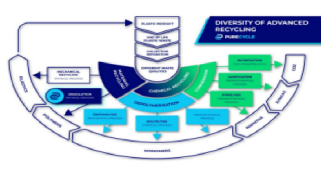
Types of Recycling
Firstly, I will explore several prioritized types of recycling
technologies used to recover important materials for future production.
-
Pyrolysis
Pyrolysis is a costly and hazardous treatment used to take apart
composite materials at high temperatures without oxygen. This process
extracts fibers from CFRPs and GFRPs and produces valuable by-products
that can replace oil and be used in mixed polymer recycling. This
treatment requires post-pyrolysis char removal and has high process
costs.
-
Mechanical Recycling
In mechanical recycling, the process of crushing, shredding, or
milling fiber-reinforced plastics (FRPs) separates fiber and resin-rich
partitions. These parts can be used as substitutes in new production.
The commonly used product, glass, is part of the glass fiber-reinforced
plastics (GFRPs) and carbon fiber-reinforced plastics (CFRPs). This
makes mechanical recycling cost-efficient and suitable for high
throughput rates. However, it can lead to economic and fiber property
loss by disrupting the physical integrity of fibers.
-
Chemical Treatment
The two main chemical treatment techniques, solvolysis and
supercritical solvolysis, produce high-quality fibers with good
mechanical strength. Solvolysis is less toxic but requires a large
number of solvents, which may alter the efficiency. Supercritical
solvolysis is cost-efficient and produces clean fibers but is more toxic
for the environment compared to solvolysis.
-
Fluidized-Bed Processing
This process achieves fibers from CFRPs and GFRPs at their highest quality by treating composite materials in a fluidized bed at extreme temperatures with less economic cost. Although this method has low economic viability, mechanical processing releases fewer pollutants, making this method less environmentally friendly.




